Stuart Mark Feldman’s
The Future in Our Hands
By Michael Newberry
Stuart Mark Feldman’s sculpture group, The Future in Our Hands (1992, Reservoir Park, Harrisburg, Pennsylvania) is four life-size bronze statues placed around a large outdoor fountain.
There are two males and two females, life-sized, each playing with a child.
(To my knowledge, this is the first review of this sculpture group since its public unveiling, ten years ago.)
Instead of first reviewing each sculpture separately, let’s look at their common features.
Each adult is standing with one leg solidly anchored on the ground, giving us the sense that they are grounded in real life. Their other leg is relaxed and slightly extended, giving them a sense of balance and flexibility. Each adult is intently looking at their child -— more: their entire body language is directed to and in support of the child. Notice how each adult has an extended free arm poised for maintaining balance. Their free arm is also extended in an expression of care.
Each child is in a moment of freedom; they are rising, reaching, or flying.
Notice that none of the children is held.
There is an intensely intimate physical connection between the adults and the children. Aside from the one child literally in flight, the other children are balancing themselves on their parents, and in beautiful exchanges of tenderness the parents are balancing the children with little more than a touch of a finger, the support of a palm, or the tip of a nose.
If we look more closely at the sculptures, we notice that each adult is a unique body type. The lithe girlish figure contrasts with the full womanly figure; the men’s figures are similarly contrasted between slender and solid builds. Notice the face of the mother tossing the child: the line of her mouth and the tilt of her nose are distinct features. We have the sense that if the model walked by we would recognize her. Each figure has unique characteristics that mark them as individuals. But common among them is the elegance of the proportions of their body parts. Not a hand, head, or foot seems out of sync with the whole body. Here Feldman has stepped away from the generic prototypes of the ancient Greeks, in which, for example, youths’ heads share the same proportions and same characteristics; yet he has retained the beauty of proportion that the Greeks innovated.
In each sculpture notice the flow of the surface skin and how it molds the underlying anatomy, from the hips to stomach up to the chest to around the shoulders. Look at the natural shape of the knees; we can sense how they are either locked into place or totally relaxed. This is a magnificent display of virtuosic modeling of the clay—the medium before the bronze casting—to resemble the real flesh of a living human being. It also shows the breadth of Feldman’s anatomical knowledge — from the delineation of a neck muscle to the hardness of an elbow; every detail is right on the money.
It might be easy to overlook the simple naturalness of the children. But several very difficult technical things are going on here. One is that their proportions are true to little children: the largeness of their heads and the fullness of their torsos. Another aspect is the modeling of their flesh, which gives us a sense of a malleable plumpness. The third is that these toddlers are in incredibly dynamic poses, the likes of which I have never seen before. Throughout the history of art, from the Egyptians to modern times, children have been mangled, distorted, prematurely aged, made into mini-bodybuilders or billowing pillows. It is amazing to find in sculpture children that look like children –in flight no less! In this sculpture group they look so obviously right that their believability emphasizes the fact that they could only have been made by a master genius.
Stepping back, let’s take in the sculptures from a distance and look at their big forms. The big form is, in contrast to details such as ears, the essential “sweep” of the whole sculpture. If you use your imagination, it is like waving a magic wand in ascending arches, in large flowing curves, or in shooting diagonal exclamation marks. Imagine that your gestured arches, curves, and diagonals magically turn into wildly arching backs, shoulders pivoting against thrust hips, and ecstatic children soaring. This is what we have in Feldman’s work.
When looking at the sculpture of the lithe woman with the flying child, follow the bow-like sweep from her right shoulder through her left hip down through left leg that ends at the curve of her left big toe. Notice how the child is flying diagonally off the sweep of the mother’s body, like an arrow shooting off a bow. Feldman uses this big sweep to dramatically accent the child’s flight.
(Parenthetically, Rodin’s greatest historical innovation was his integration of big sweeping forms of the human body—which he used to give a sense of immediacy, of living in the moment, to the expression of the figure. His figures never feel “posed,” unlike the melodramatic poses you might see in silent movies. It is outside of the scope of this essay, but it could be argued that Rodin sacrificed proportions, the flesh-like texture of the modeling, and the completeness of the entire figure so that he could achieve the big sweep of immediacy and form. On the other hand, Feldman has integrated this technique without sacrificing any of these other sculptural values.)
A swirling twist of space is the big form in the sculpture of the child who is raising himself from his mother’s shoulder. She is taking a step, rotating in the direction of her turned head, following the direction of her child, whose back enhances this line and whose head is turned in such a way as to continue this sweep out towards his furthest sight. The whole composition is like a waltz of balance.
Looking at the sculpture of the child balanced on his father’s shoulder, we can sense a flowing “S” sweep from the father’s right leg, swinging up through his torso, curving through the tilting torso of the child, ending in a burst of joyfully flung arms and legs, much like the ascent and explosion of fireworks.
Perhaps the most impressive of the four sculptures is the one in which the father has raised the delighted child on high. Notice the soaring line from the father’s right shoulder through his arm up through the child’s high-flung leg.
In every one of these pieces we see a historically unique sculpture because of the inventive use of the big form and because of a thoroughly modern presentation of a new humanity. The Future in Our Hands is a tour de force of integration; the scope of the work is startling.
The Future in Our Hands is seamlessly integrated through the theme of the joy of supporting human growth. The work encompasses minute detail, from a mother carefully balancing her child with index finger and a nudge of her nose to the monumental abstract design that sweeps a child through space. It expresses the significance of individuals grounded on this earth, and it magnifies the importance for them of supporting their benevolent stance with care, attention, and joy. It expresses the unselfconscious exhilaration of living in the present with an eye towards the future.
The Future in Our Hands is an innovative masterpiece. It is a landmark. It is one of several contemporary masterpieces that will mark the end of the postmodern era and set an aesthetic precedent for the beginning of new era of enlightenment in the arts.
Notes:
Brett Holverstott’s photos of Feldman’s sculpture group can be seen here.
This review by Michael Newberry is excerpted from “Pandora’s Box: The Newly-Discovered Version.”

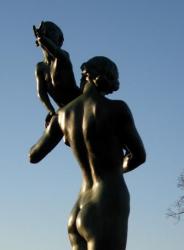
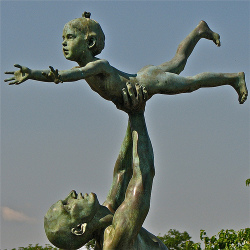
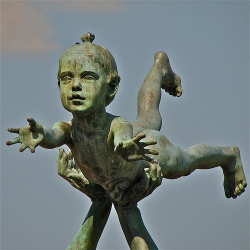
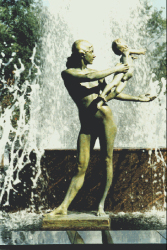
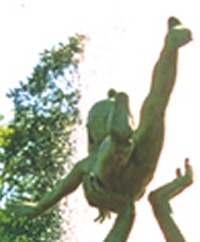
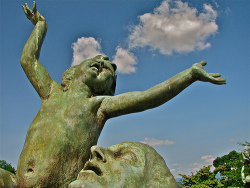
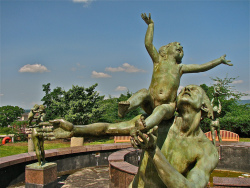
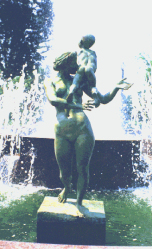
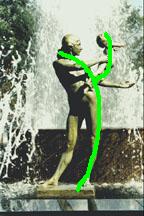
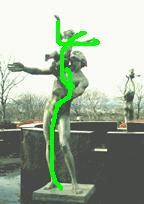
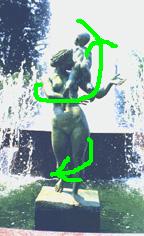
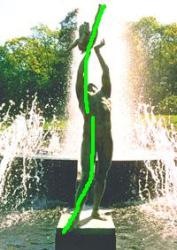
Beautiful work. First I’ve heard of it.